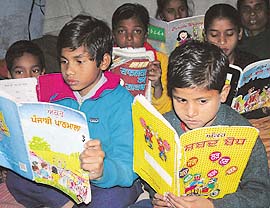drkhalsa
SPNer
- Sep 16, 2004
- 1,308
- 54
West of Orissa, east of Punjab
The Oriyas arrived in the Holy City more than 50 years ago and have gradually assimilated their own unique culture with the traditions of Punjab. They have nurtured a new generation which is at home in both the north and the east, says Varinder Walia
A view of the Orissa Durga Mata Mandir on Majitha Road here. — Photo by Rajiv Sharma

 Glorious past
Glorious past
 The path home
The path home
 Ancient language
Ancient language
Children from Oriya families read a Gurmukhi primer in school. — Photo by Rajiv Sharma




Children from Oriya families read a Gurmukhi primer in school. — Photo by Rajiv Sharma
While students of some public schools in Amritsar, run by certain Sikh families get punished for speaking Punjabi, the children of Oriya origin, settled in Amritsar, take pride in reading and writing Gurmukhi (the script used for writing Punjabi).
Some of the Oriya youths who were born in Amritsar or other parts of Punjab even wear turbans and it is difficult to differentiate them from local Sikhs. Even their names, like Ranjita and Bhola, might make a stranger believe that they hail from some village in Punjab.
The Oriyas here therefore represent a blend of various elements. Although there are many languages and dialects spoken in Orissa, Punjabi is perhaps a new language that the new generation has learnt.
Though these Punjab-born children find it hard to read or write their own language or any of its dialects, the family has made them learn their mother tongue, keeping the kids in touch with their roots.
These children are studying in schools like Sacred Heart, St Mary’s School and educational institutes run by Anand Marga.
Chaturbhush, an elderly Oriya, says their population in the Holy City has already crossed 5000. “This is the reason that politicians throng the Durga Temple on the main Majitha Road, especially during the Municipal polls, to seek blessings.”
The number of Oriyas in Punjab is stated to be more than 50,000.
Damodar, who has a good command over Punjabi, says their community has been performing Durga Puja in Amritsar for the last 47 years, indicating that they started settling in the city more than half-a-century ago.
The first Oriya who came here was late Bhagwan Dass. He arrived in Amritsar as a plumber accompanying a big businessman from Calcutta in 1950. Later, he brought his near and dear ones from Orissa to the city.
Then came Mathura Dass, Jadumani, Sanatan, K.C. Dass, Drub Dass, Onkar Dass, Ravi Aruk and so on …
Though most of the Oriyas here work as plumbers and fitters, some of them have succeeded in getting government jobs .
And though most have constructed their pacca houses in various parts of Punjab, they have not forgotten their roots. They hold their elders in high-esteem and invariably prefer to get married in their ancestral villages. The command given by their elders is accepted like religious hukamnama.
The localities where these Oriyas have settled in Amritsar include Jagdambe Colony, Bengali Colony, Gopal Nagar and Sandhu Colony.
Creating a home away from home, they perform their festivals with great religious fervour. When the Rathyatra is taken out from the Jagannath Temple at Puri, a similar chariot is taken out in the city. The massive participation of Oriyas in the Rath Yatra gives an impression that the local Majitha Road is perhaps a part of some small Orissa town.
The Rath Yatra is taken out in honour of Lord Jagannath, believed to be an incarnation of Lord Vishnu.
Shivaratri is another important festival in the annual cycle of rituals celebrated in the month of Phalguna (February-March) by the Oriyas. The fair draws pilgrims from far–flung areas of the border town and devotees fast till after midnight when the sacred lamp (Mahadeepa) is taken to the temple spire.
The Oriya women decorate their homes with white murals. Their motifs are derived from landscape back home.
The Oriyas take pride in their artistic skills displayed in their temples, handicrafts, paintings, music and dance.
They have distinctive identities in terms of cultural institutions, social customs and linguistic and literary sophistication. Yet their men folk easily mingle with the locals.
However, the women folk prefer to confine themselves to their house only.
Each Oriya caste has its own cultural world and social milieu, with its particular festivals and rituals, its own tutelary deities and sacred centres, its peculiar marriage, funeral and other customs, and its own level and limitations of social interaction with members of other castes and religious communities in the village society. But bonds were nevertheless established through a peculiar social institution called ritual kinship and friendship. This institution ensured a semblance of social interaction between the families of persons so related.

